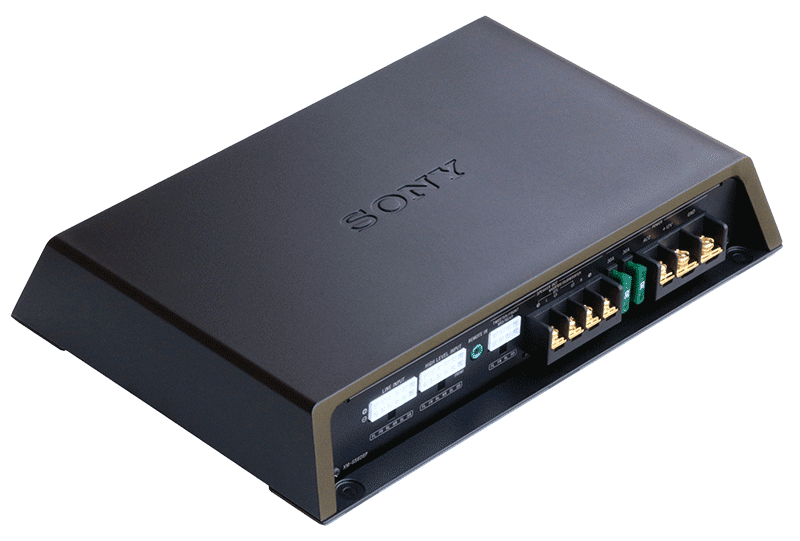 Text and Measurements by Dave MacKinnon
Text and Measurements by Dave MacKinnon
Sitting on a table or mounted to a display board, most car audio amplifiers seem about the same. Sony has created something different with its XM-GS6DSP amplifier. Features like Bluetooth audio streaming, digital signal processing and three-way electronic crossovers make this a flexible solution for any audio enthusiast. Read on to find out how the Sony XM-GS6DSP can be the heart of an impressive mobile sound system upgrade.
Physical Design
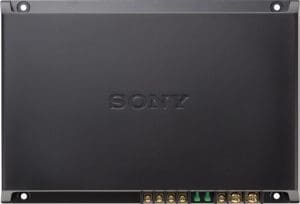 The XM-GS6DSP amplifier measures a compact 11⅝ inches wide and 7⅞ inches deep while standing just a smidge over 2 inches in height. The amp weighs 5 pounds 12 ounces and features a handsome satin black finish with the Sony logo embossed into the top. Mass is relevant in modern amplifiers as most heatsinks rarely use fins to help remove heat from the power supply and output switching devices.
The XM-GS6DSP amplifier measures a compact 11⅝ inches wide and 7⅞ inches deep while standing just a smidge over 2 inches in height. The amp weighs 5 pounds 12 ounces and features a handsome satin black finish with the Sony logo embossed into the top. Mass is relevant in modern amplifiers as most heatsinks rarely use fins to help remove heat from the power supply and output switching devices.
All the power and signal connections are on one edge of the amp while the analog adjustments are along the top edge. Signal input options include three pairs of line-level inputs and six speaker-level input connections. The input mode selection switch lets your installer configure the amp for two channels of audio input with five output channels and connectivity with the internal high-quality Sony BT receiver and digital processing features. The amp can also function as a conventional six-channel analog solution. I’ll talk more about the configuration in the Application section of this review.
Analog Audio Features
Each pair of channels has a dedicated analog sensitivity control rated for 0.2 to 6V of input signal. The Tweeter/Front channel crossover can be adjusted between 500Hz and 4kHz in a high-pass mode while the Woofer/Subwoofer channels have a low-pass filter adjustable from 50Hz to 500Hz. The Mid/Rear channels have two crossovers. The high-pass crossover is adjustable from 50Hz to 500Hz while the low-pass crossover can be set between 500Hz and 4kHz. A function selection switch on the mid/rear lets your installer decide if those channels will operate in high-pass only or a bandpass configuration with both filters engaged. The woofer/subwoofer channel includes a bass boost control adjustable from 0 to 10dB.
Digital Audio Features
 Using the Sony | Music Center and Advanced Car Audio Setting apps on an Android or iOS-based smartphone or tablet gives you access to more configuration options for the amp. The apps include a graphic equalizer, 4.1-channel signal delay configuration and adjustment for balance, fader, subwoofer level and a loudness function. You also get subwoofer level control and master volume control when streaming from your smart device. The equalizer provides 10 bands of equalization and includes nine preset curves. The Karaoke setting works quite well – yes, I did try it!
Using the Sony | Music Center and Advanced Car Audio Setting apps on an Android or iOS-based smartphone or tablet gives you access to more configuration options for the amp. The apps include a graphic equalizer, 4.1-channel signal delay configuration and adjustment for balance, fader, subwoofer level and a loudness function. You also get subwoofer level control and master volume control when streaming from your smart device. The equalizer provides 10 bands of equalization and includes nine preset curves. The Karaoke setting works quite well – yes, I did try it!
The signal delay settings are adjustable in 1-cm steps for the four main channels and the subwoofer and are adjustable from 30 to 300 cm. The app includes presets for left, right, front, all and custom listening positions. Your installer can fine-tune each preset or set the delays manually to ensure the sound from each speaker and subwoofer arrives at the listening position simultaneously.
The Music Center app lets you stream music stored on your phone or select apps like Waze, YouTube and Google as additional audio sources. Once paired to your phone, you don’t need a radio of any kind.
Amplifier Power and Signal Connections
 The connection side of the amp has a pair of 12-position Molex connections for the line-level and speaker-level inputs. An eight-position Molex connector handles the speaker outputs for the four main channels. All speaker connections follow the ISO 10487 standard with pairs of white, grey, green and violet wires. The subwoofer output channels use a four-position, gold-plated barrier strip that will accept bare wires or spades up to 0.35 inches in width.
The connection side of the amp has a pair of 12-position Molex connections for the line-level and speaker-level inputs. An eight-position Molex connector handles the speaker outputs for the four main channels. All speaker connections follow the ISO 10487 standard with pairs of white, grey, green and violet wires. The subwoofer output channels use a four-position, gold-plated barrier strip that will accept bare wires or spades up to 0.35 inches in width.
A three-position barrier strip handles power connections. The power and ground locations will accept 0.55-inch spades and the remote turn-on connection matches the subwoofer output’s 0.35-inch width. Sony includes a rubber boot to protect the power connections. A pair of 30-amp ATC fuses on the chassis protects the vehicle electrical system and wiring.
It’s worth noting that the blue wire on the subwoofer channel of the speaker input connector needs to see DC voltage for the analog input stage of the amp to activate. Installers should take special care to read the wiring instructions on pages 9 and 12 of the included manual to properly apply this blue wire.
Internal Design and Components
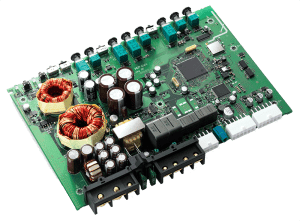 When looking at the XM-GS6DSP, the top of the amp is a high-mass cast-aluminum heatsink that is robust enough to withstand crushing from feet if mounted under a seat or from objects rolling around in a trunk. A secondary aluminum casting is screwed to the underside of that heat sink to provide direct contact with the switching devices on the back of the circuit board. Two aluminum mounting brackets allow the amp to be secured in your vehicle.
When looking at the XM-GS6DSP, the top of the amp is a high-mass cast-aluminum heatsink that is robust enough to withstand crushing from feet if mounted under a seat or from objects rolling around in a trunk. A secondary aluminum casting is screwed to the underside of that heat sink to provide direct contact with the switching devices on the back of the circuit board. Two aluminum mounting brackets allow the amp to be secured in your vehicle.
Inside, the amplifier has a pair of power supplies: one for the main channels and one dedicated to the subwoofer channels. Power fed into the amp passes through a pair of inductors to prevent switching noise from feeding back into the vehicle.
Unlike most amplifiers, the XM-GS6DSP features a large CPU from Renesas Electronics Corp. that features an ARM Cortex A9 core. The CPU handles the Bluetooth pairing process and communication of commands to the DSP. A Sony Advanced Sound Engine with DSP handles the modifications to the audio signal. A Bluetooth 3.0 receiver module with an external antenna in the corner of the amp takes care of wireless communication. Uniquely, the amp is two-thirds amplifier and one-third source unit in terms of hardware.
The subwoofer power supply uses four International Rectifier 65V, 104A surface-mount MOSFETs for switching. Four 50V, 1500uF caps regulate output voltage. The main channel supply uses two ON Semiconductor 60V, 100A MOSFETs for switching and is filtered by a pair of 25V, 1800 uF caps. All of the output switching devices are also surface-mount units. All outputs are filtered by enclosed inductors to smooth the audio signal and further reduce the chance of RF Interference.
Test Bench Performance
I started the testing process by setting the amp up on my bench and feeding it with a pair of 80-amp switching power supplies. All measurements were taken using a D’Amore Engineering SMD AMM-1 and levels were set using an SMD DD-1 Distortion Detector. I use several banks of high-power ceramic wire-wound resistors as loads. Even at slightly under the rated test voltage, the XM-GS6DSP had no problem producing its rated power.
Power Measurements
Rated: 45 x 4 @ 4 Ohms + 350 x 1 at 4 Ohms at 14.4V
Measured: 49.5 x 4 @ 4 Ohms + 379 x 1 @ 4 Ohms at 13.8V
Rated: 45W x 4 at 4 Ohms + 600W x 1 at 2 Ohms at 14.4V
Measured: 46.8W x 4 at 4 Ohms + 607W at 2 Ohms at 14.2V
Up next, I measured frequency response on the main and subwoofer channels using my engineering-grade digital interface. I also made several sweeps to confirm the slope and functionality of the crossovers and bass boost functions. Figures 3 through 7 show the frequency response measurements.
Frequency Response
Level -3dB Low -1dB Low -1dB High -3dB High
Main Channels 14.6Hz 25.8Hz 20.81kHz 21.2kHz
Sub Channels 8.92Hz 15.5Hz 2.67 kHz 7.83kHz
Front/Tweeter Channel Crossover Response
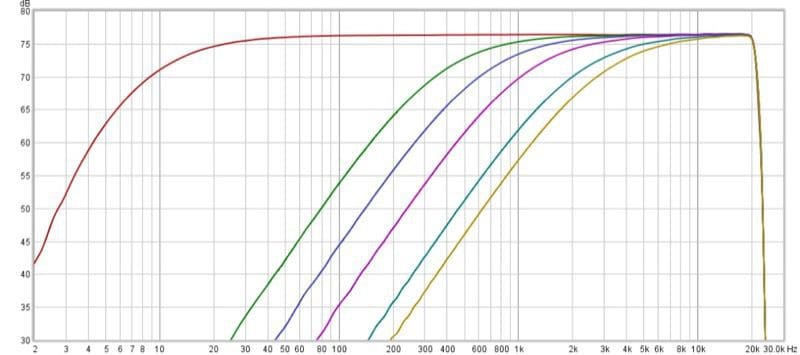
Rear/Mid Channel HPF Crossover Response
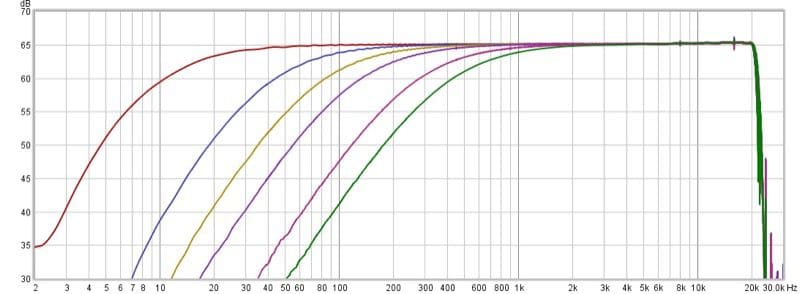
Rear/Mid Channel HPF and LPF Crossover Response
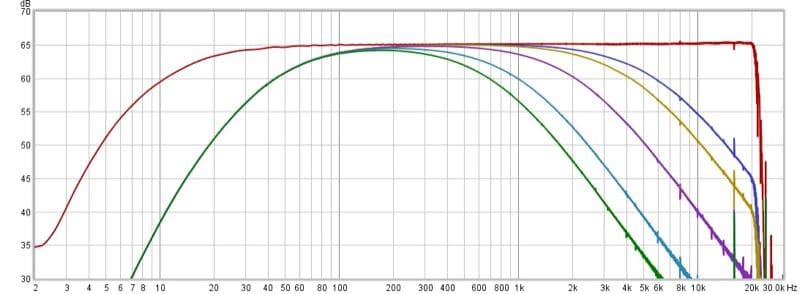
Subwoofer Channel LPF Crossover Response
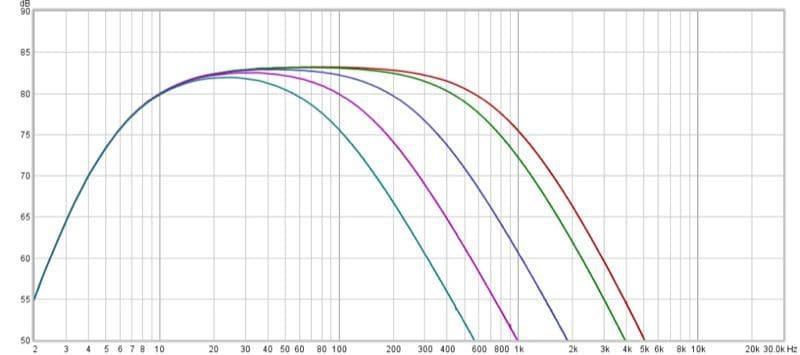
Subwoofer Channel Bass Boost Response
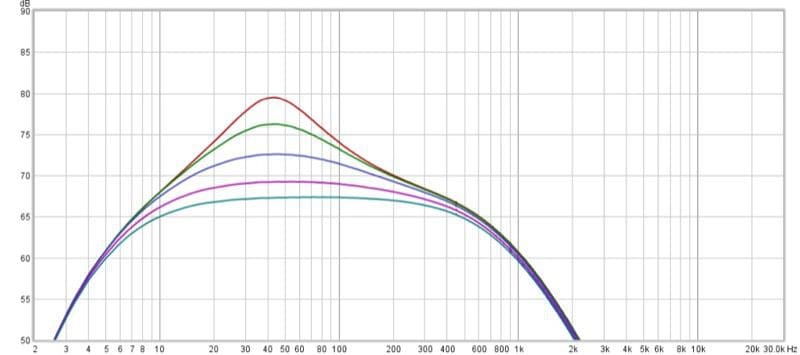
All the crossovers behaved as expected; there were no anomalies in any of the response measurements and the filter response is -12dB/octave. The bass boost function is centered at 42.8Hz with a maximum boost level of 12dB. The bandwidth on the boost is fairly wide, so the feature won’t produce an unrealistic peak in the bass response unless used aggressively.
Adjusting any of the DSP settings results in a very brief pause in audio playback while the setting is applied to the signal. This pause is normal for the majority of the processors on the market.
Listening Test
With the amp thoroughly abused on the bench, it was time to set it up for a listen. I connected it to my Polk Audio LSi9 bookshelf speakers and an old Elemental Designs e10A subwoofer. I happen to have a Sony RSX-GS9 head unit in my lab to serve as the signal source. All the audio files are in the FLAC format and have come from their original compact discs.
I started with Dire Straits’ “Money for Nothing” to get a sense of focus across the soundstage. The XM-GS6DSP had no problem placing the drum beats perfectly in their place. The lead guitar came through clearly, and its raunchy distorted sound was detailed. Once the song got going, the bass line was solid and had decent impact, even at elevated listening levels.
Next up was “Brothers in Arms.” This track has long, drawn-out notes that can accentuate subtle balance issues. The amp did a great job reproducing everything, including the room reverberation in the percussion. Knopfler’s voice was layered nicely into the mix.
I finished with “Sky Blue” by Peter Gabriel. The shaker is well-centered and reproduced clearly behind Peter’s voice. The background percussion was wide and the bass line was solid with good detail.
Overall, sonic performance is solid with no glaring issues. In fact, at this price point, the performance is thoroughly impressive and, quite honestly, a lot of fun. Are there sonic benefits from spending twice as much money on a similar solution? Sure, there are supposed to be. But in terms of bang-for-the-buck enjoyment, the XM-GS6DSP is awesome.
Amplifier Application Options
If there is a concept that takes some effort to grasp with the XM-GS6DSP, it would be the multitude of available system configurations. I’ll review a few of the options that will be the most popular.
Three-Way System
 Given my druthers, I’d suggest combining this amp with a subwoofer (or two) and a two-way component set. The subwoofer will, of course, find its home on the Woofer/Subwoofer channels. If you are using a component set like the Sony XS-GS1621C, the woofers should be on the Rear/Mid channels and the tweeters on the Front/Tweeter channels. The installer can use the bandpass crossover to filter the top of the mid at 4000 Hz to complete the transition to the tweeter – a feature most amps at this price point can’t offer.
Given my druthers, I’d suggest combining this amp with a subwoofer (or two) and a two-way component set. The subwoofer will, of course, find its home on the Woofer/Subwoofer channels. If you are using a component set like the Sony XS-GS1621C, the woofers should be on the Rear/Mid channels and the tweeters on the Front/Tweeter channels. The installer can use the bandpass crossover to filter the top of the mid at 4000 Hz to complete the transition to the tweeter – a feature most amps at this price point can’t offer.
Four-Way System
If you choose to use the three-way XS-G1631C speaker set with a subwoofer, your installer can set the midrange and tweeter up on the Tweeter/Front channels using the included passive bi-amp capable crossover networks with the amplifier crossover set at its 500 Hz setting. The mid-bass drivers will be on the Rear/Mid channels and the subs on the Woofer/Subwoofer channel.
In either of the above configurations, your installer can use the signal delay, balance, fader and equalization features of the amp to fine-tune the installation for vehicle-based acoustic response and speaker position. The result will be a thoroughly enjoyable listening experience with a soundstage that spans the width of the vehicle and excellent instrument placement. When tuned properly, it can sound like the sub is on the dash as well!
Front, Rear and Subwoofer System
Defeating the Front/Tweeter high-pass crossover allows you to use the amp to power front and rear speakers and a subwoofer. If you set the input selector switch to the six-channel mode, the internal DSP is bypassed and you can feed whatever signals you want into the amp’s inputs. If you are using a source unit with built-in processing, have an external DSP or simply want to increase the power sent to the speakers in your factory-installed sound system, this would be a great option.
Conclusion
The Sony XM-GS6DSP packs a lot of features and performance into a small package. If you want a stand-alone amp for your vehicle, this is a great choice at an aggressive price. The power available for a subwoofer is truly impressive for a chassis of this size. The 4.1-channel DSP gives installers tuning flexibility that is simply unmatched at this price point. The integrated Bluetooth audio streaming is a great solution for older vehicles, boats and RVs where it can be mounted in a protected area, and other types of vehicles without hands-free functionality where you don’t want a source unit at all. When it’s time to upgrade your mobile sound system, drop by your local authorized Sony dealer and check out the XM-GS6DSP amplifier.
What I Love
4.1-channel signal delay and 10-band EQ built in
Flexible three-way electronic crossovers
Impressive subwoofer channel power
Bluetooth audio streaming
Small chassis
What I’d Change
More range on the Front/Tweeter high-pass filter
Add weatherproofing for marine and powersports applications
